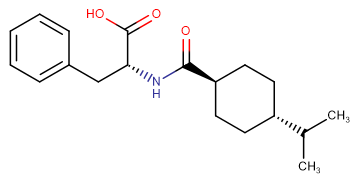
Nateglinide
CAS No. 105816-04-4
Nateglinide( A-4166 | SDZ-DJN 608 )
Catalog No. M10264 CAS No. 105816-04-4
Nateglinide is an oral antihyperglycemic agent used for the treatment of non-insulin-dependent diabetes mellitus (NIDDM).
Purity : >98% (HPLC)
 COA
COA
 Datasheet
Datasheet
 HNMR
HNMR
 HPLC
HPLC
 MSDS
MSDS
 Handing Instructions
Handing Instructions
| Size | Price / USD | Stock | Quantity |
| 10MG | 37 | In Stock |


|
| 25MG | 75 | In Stock |


|
| 50MG | 133 | In Stock |


|
| 100MG | 224 | In Stock |


|
| 200MG | 323 | In Stock |


|
| 500MG | Get Quote | In Stock |


|
| 1G | Get Quote | In Stock |


|
Biological Information
-
Product NameNateglinide
-
NoteResearch use only, not for human use.
-
Brief DescriptionNateglinide is an oral antihyperglycemic agent used for the treatment of non-insulin-dependent diabetes mellitus (NIDDM).
-
DescriptionNateglinide is an oral antihyperglycemic agent used for the treatment of non-insulin-dependent diabetes mellitus (NIDDM). It belongs to the meglitinide class of short-acting insulin secretagogues, which act by binding to cells of the pancreas to stimulate insulin release. Nateglinide is an amino acid derivative that induces an early insulin response to meals decreasing postprandial blood glucose levels. It should only be taken with meals and meal-time doses should be skipped with any skipped meal. Approximately one month of therapy is required before a decrease in fasting blood glucose is seen. Meglitnides may have a neutral effect on weight or cause a slight increase in weight. The average weight gain caused by meglitinides appears to be lower than that caused by sulfonylureas and insulin and appears to occur only in those na?ve to oral antidiabetic agents. Due to their mechanism of action, meglitinides may cause hypoglycemia although the risk is thought to be lower than that of sulfonylureas since their action is dependent on the presence of glucose. In addition to reducing postprandial and fasting blood glucose, meglitnides have been shown to decrease glycosylated hemoglobin (HbA1c) levels, which are reflective of the last 8-10 weeks of glucose control. Meglitinides appear to be more effective at lowering postprandial blood glucose than metformin, sulfonylureas and thiazolidinediones. Nateglinide is extensively metabolized in the liver and excreted in urine (83%) and feces (10%). The major metabolites possess less activity than the parent compound. One minor metabolite, the isoprene, has the same potency as its parent compound.(In Vitro):Nateglinide inhibits typical recordings of dinitrophenol-induced KATP currents in a concentration-dependent manner. Nateglinide exhibits IC50 values of 7.4 μM and 2.4 μM for 5 mM glucose (G5) and 16 mM (G16) glucose, respectively.(In Vivo):Nateglinide (50mg/kg, orally in mice) stimulates human C-peptide secretion in the humanized mice and improved postprandial glucose concentrations.
-
In VitroNateglinide inhibits typical recordings of dinitrophenol-induced KATP currents in a concentration-dependent manner. Nateglinide exhibits IC50 values of 7.4 μM and 2.4 μM for 5 mM glucose (G5) and 16 mM (G16) glucose, respectively. RT-PCR Cell Line:Rat pancreatic β-cells.Concentration:0-100 μM.Incubation Time:~20 min.Result:Produced a complete inhibition of KATP current at concentration of 3 μM.
-
In VivoNateglinide (50mg/kg, orally in mice) stimulates human C-peptide secretion in the humanized mice and improved postprandial glucose concentrations. Animal Model:Mice.Dosage:50mg/kg.Administration:Orally at 60min before oral administration of 4 g/kg glucose.Result:Stimulates human C-peptide secretion.
-
SynonymsA-4166 | SDZ-DJN 608
-
PathwayCell Cycle/DNA Damage
-
TargetPotassium Channel
-
RecptorPotassium Channel| PPARγ
-
Research AreaCardiovascular Disease
-
Indication——
Chemical Information
-
CAS Number105816-04-4
-
Formula Weight317.42
-
Molecular FormulaC19H27NO3
-
Purity>98% (HPLC)
-
SolubilityEthanol: 63 mg/mL (198.47 mM); DMSO: 63 mg/mL (198.47 mM)
-
SMILESO=C(O)[C@@H](CC1=CC=CC=C1)NC([C@H]2CC[C@H](C(C)C)CC2)=O
-
Chemical Name(R)-2-((1r,4R)-4-isopropylcyclohexanecarboxamido)-3-phenylpropanoic acid
Shipping & Storage Information
-
Storage(-20℃)
-
ShippingWith Ice Pack
-
Stability≥ 2 years
Reference
1.Hu S, et al. J Pharmacol Exp Ther. 2000 May;293(2):444-52.
molnova catalog



related products
-
KCNQ1 activator-1?
2-Piperidinecarboxamide, N-[4-(4-methoxyphenyl)-2-thiazolyl]-1-(phenylsulfonyl)- is a potent KCNQ1 channel activator that can be used in long QT syndrome (LQTS) studies.
-
Gliclazide
Gliclazide is a whole-cell beta-cell ATP-sensitive potassium currents blocker with an IC50 of 184 nM.
-
Amsacrine
Amsacrine (mAMSA) an antineoplastic agent which can intercalate into the DNA of tumor cells.



 Cart
Cart
 sales@molnova.com
sales@molnova.com


